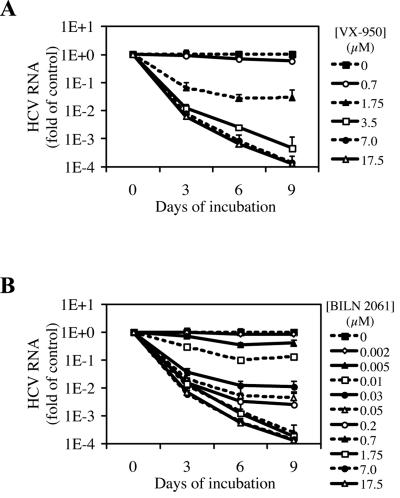| CAS NO: | 402957-28-2 |
| 规格: | ≥98% |
| 包装 | 价格(元) |
| 1mg | 电议 |
| 2mg | 电议 |
| 5mg | 电议 |
| 10mg | 电议 |
| 25mg | 电议 |
| 50mg | 电议 |
| 100mg | 电议 |
| 250mg | 电议 |
| 500mg | 电议 |
| Molecular Weight (MW) | 679.85 |
|---|---|
| Formula | C36H53N7O6 |
| CAS No. | 402957-28-2 |
| Storage | -20℃ for 3 years in powder form |
| -80℃ for 2 years in solvent | |
| Solubility (In vitro) | DMSO: 136 mg/mL (200.0 mM) |
| Water: <1 mg/mL | |
| Ethanol: <1 mg/mL | |
| Solubility (In vivo) | 30% PEG400+0.5% Tween80+5% propylene glycol: 30 mg/mL |
| Synonyms | VX-950, LY-570310, MP-424; VX950, LY570310, MP424; VX 950, LY 570310, MP 424; trade names: Incivek; Incivo Chemical Name: (3S,3aS,6aR)-2-[(2S)-2-[[(2S)-2-cyclohexyl-2-(pyrazine-2-carbonylamino)acetyl]amino]-3,3-dimethylbutanoyl]-N-[(3S)-1-(cyclopropylamino)-1,2-dioxohexan-3-yl]-3,3a,4,5,6,6a-hexahydro-1H-cyclopenta[c]pyrrole-3-carboxamide InChi Key: BBAWEDCPNXPBQM-GDEBMMAJSA-N InChi Code: InChI=1S/C36H53N7O6/c1-5-10-25(29(44)34(48)39-23-15-16-23)40-33(47)28-24-14-9-13-22(24)20-43(28)35(49)30(36(2,3)4)42-32(46)27(21-11-7-6-8-12-21)41-31(45)26-19-37-17-18-38-26/h17-19,21-25,27-28,30H,5-16,20H2,1-4H3,(H,39,48)(H,40,47)(H,41,45)(H,42,46)/t22-,24-,25-,27-,28-,30+/m0/s1 SMILES Code: O=C([C@@H]1[C@](CCC2)([H])[C@]2([H])CN1C([C@@H](NC([C@H](C3CCCCC3)NC(C4=NC=CN=C4)=O)=O)C(C)(C)C)=O)N[C@@H](CCC)C(C(NC5CC5)=O)=O |
| In Vitro | In vitro activity: Telaprevir inhibits the hepatitis C virus NS3-4A serine protease, leading to the block of viral polyprotein processing and subsequently decrease of viral RNA replication, total HCV RNA levels and protein levels in the Con1 (genotype 1b) subgenomic HCV replicon cells in a time- and dose-dependent manner. Telaprevir displays a significant time-dependent increase in inhibitory effect on the replication of HCV RNA with IC50 values of 0.574 μM, 0.488 μM, 0.210 μM and 0.139 μM for 24, 48, 72 and 120 hours incubation, respectively. Telaprevir displays an average IC50 of 0.354 μM and an average IC90 of 0.830 μM, respectively, from three independent experiments using the 48 hours incubation. Telaprevir has no significant cytotoxicity to HCV replicon cells, parental Huh-7 and HepG2 cells after 48 hours incubation. Telaprevir (17.5 μM) completely eradicates HCV RNA from replicon cells after 13 days incubation without rebound after Telaprevir is withdrawn. Telaprevir displays an additive to moderate synergistic effect on reduction of HCV RNA replication and suppression of resistance mutations without significant increase in cytotoxicity when in combination with IFN-α, compared to treatment with each agent alone. Kinase Assay: Stable Huh-7 cells containing the self-replicating, subgenomic HCV replicon, which is identical in sequence to the I377neo/NS3-3'/wt replicon are used for anti-HCV assays. Replicon cells are incubated at 37 °C for the indicated period of time with Telaprevir serially diluted in DMEM plus 2% FBS and 0.5% dimethyl sulfoxide (DMSO). Total cellular RNA is extracted using an RNeasy-96 kit, and the copy number of HCV RNA is determined using a quantitative RTPCR (QRT-PCR) assay for the assessment of 50% inhibitory concentration (IC50). Cell Assay: Cells (Huh-7, HepG2, and peripheral blood mononuclear cells (PBMC)) are incubated with various concentrations of Telaprevir for 48 hours. Cell viability is determined by using a tetrazolium (MTS)-based cell viability assay. |
|---|---|
| In Vivo | Oral administration of Telaprevir reduces HCV protease-dependent cleavage and subsequent secretion of SEAP from the liver into the blood in the mice model to 18.7% and 18.4% at dosage of 10 and 25 mg/kg, respectively. Administration of Telaprevir at 200 mg/kg for 1 week results in a 1.9 log reduction of HCV RNA in genotype 1b HCV-infected human hepatocyte chimeric mice, and when treatment in combination with MK-0608 (50 mg/kg) for 4 weeks, viruses are eliminated from mice. |
| Animal model | SCID mice injected with recombinant adenovirus (Ad-WT-HCVpro-SEAP or Ad-MT-HCVpro-SEAP) |
| Formulation & Dosage | Formulated in polyvinylpyrrolidone (PVP) K-30 plus 2% sodium lauryl sulfate; 300 mg/kg; P.O. |
| References | Antimicrob Agents Chemother. 2006 May;50(5):1813-22; Antimicrob Agents Chemother. 2006 Mar;50(3):899-909; J Hepatol. 2011 May;54(5):872-8. |
 |  |  |
 |  |  |
